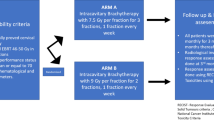Abstract
Introduction
Though high dose rate (HDR) intracavitary brachytherapy (ICBT) is now an integral part in the treatment of cervical cancer, the quest for optimum dose and fractionation schedule is still ongoing. While the American Brachytherapy Society recommends individual fraction size of <7.5 Gy, there are few studies where the authors obtained similar results with higher dose per fraction.
Objective
To compare and analyse two high-dose-rate intracavitary brachytherapy schedules—7 Gy per fraction for three fractions with 9 Gy per fraction for two fractions.
Materials and Methods
This is a prospective institutional study in Southern India carried on from 1 June 2012 to 31 March 2013. In this period, 124 patients of cervical cancer satisfying our inclusion criteria were treated with concurrent chemo-radiation, following which patients were randomized to one of the treatment arms, with 62 patients in each arm. The ICBT dose in Control Arm A was 7 Gy per fraction in three fractions, 1 week apart. While in Study Arm B, the ICBT dose was 9 Gy per fraction in two fractions, again 1 week apart. One patient in Arm A and three patients in Arm B discontinued the treatment even after repeated counselling and hence were excluded from the study analysis.
Results
The median follow-up period in the study was 25.2 months. In the Control Arm A, the 2-year actuarial local control rate, disease-free survival and overall survival were 88.5, 86.9 and 92.6 %, respectively, while in the Study Arm B, the 2-year actuarial local control rate, disease-free survival and overall survival were 91.5, 88.1 and 86.4 %, respectively.
Conclusion
In our experience, HDR brachytherapy with 9 Gy per fraction in two fractions is an effective dose fractionation when compared to 7 Gy per fraction in three fractions.



Similar content being viewed by others
References
GLOBOCAN 2012: Estimated cancer incidence, mortality and prevalence worldwide in 2012, World Health Organization. http://www.globocan.iarc.fr/old/FactSheets/cancers/cervix-new.aspx. Last Accessed on 4 Nov 2014.
Burden of HPV related cancers. Human Papillomavirus and Related Diseases Report India. http://www.hpvcentre.net. Last Accessed on 15 Oct 2014.
Sood BM, Gorla G, Gupta S, et al. Two fractions of high-dose-rate brachytherapy in the management of cervix cancer: clinical experience with and without chemotherapy. Int J Radiat Oncol Biol Phys. 2002;53:702–6.
Nakano T, Kato S, Ohno T, et al. Long-term results of high-dose rate intracavitary brachytherapy for squamous cell carcinoma of the uterine cervix. Cancer. 2005;103:92–101.
Nag S, Erickson B, Thomadsen B, et al. The American Brachytherapy Society recommendations for high-dose-rate brachytherapy for carcinoma of the cervix. Int J Radiat Oncol Biol Phys. 2000;48(1):201–11.
Patel FD, Kumar P, Karunanidhi G, et al. Optimization of high-dose-rate intracavitary brachytherapy schedule in the treatment of carcinoma of the cervix. Brachytherapy. 2011;02(10):147–53.
Patel FD, Rai B, Mallick I, et al. High-dose-rate brachytherapy in uterine cervical carcinoma. Int J Radiat Oncol Biol Phys. 2005;62:125–30.
Patel FD, Sharma SC, Negi PS, et al. Low dose rate versus high dose rate brachytherapy in the treatment of carcinoma of the uterine cervix: a clinical trial. Int J Radiat Oncol Biol Phys. 1994;28(2):335–41.
ICRU Report #38. Dose and volume specification for reporting intracavitary therapy in oncology. International Commission on Radiation Units and Measurements. Bethesda. March 1985:1.
Cox JD, Stetz J, Pajak TF. Toxicity criteria of the radiation therapy oncology group (RTOG) and the European organization for research and treatment of cancer (EORTC). Int J Radiat Oncol Biol Phys. 1995;31:1341–6.
Petereit DG, Pearcey R. Literature analysis of high dose rate brachytherapy fractionation schedules in the treatment of cervical cancer: is there an optimal fractionation schedule? Int J Radiat Oncol Biol Phys. 1999;43:359–66.
Orton GC, Seyedsadr M, Somnay A. Comparison of high and low dose rate remote after loading for cervix cancer and the importance of fractionation. Int J Radiat Oncol Biol Phys. 1991;21:1425–34.
Orton GC. Width of the therapeutic window: what is the optimal dose-per-fraction for high dose rate cervix cancer brachytherapy? Int J Radiat Oncol Biol Phys. 1995;31:1011–3.
Souhami L, Corns R, Duclos M, et al. Long-term results of high-dose rate brachytherapy in cervix cancer using a small number of fractions. Gynecol Oncol. 2005;97:508–13.
Author information
Authors and Affiliations
Corresponding author
Ethics declarations
Conflict of interest
None.
Ethical Standards
All procedures performed in studies involving human participants were in accordance with the ethical standards of the institutional and/or national research committee and with the 1964 Declaration of Helsinki and its later amendments or comparable ethical standards.
Informed Consent
Research involving human participants—Informed consent was obtained from all individual participants included in the study.
Additional information
Dr. Saptarshi Ghosh M.B.B.S, M.D. is Radiation Oncologist at GSL Cancer Hospital, GSL Medical College & General Hospital, Rajahmundry, Andhra Pradesh, India.
Rights and permissions
About this article
Cite this article
Ghosh, S., Rao, P. High-Dose-Rate Orthogonal Intracavitary Brachytherapy with 9 Gy/Fraction in Locally Advanced Cervical Cancer: Is it Feasible??. J Obstet Gynecol India 66 (Suppl 1), 452–458 (2016). https://doi.org/10.1007/s13224-015-0812-8
Received:
Accepted:
Published:
Issue Date:
DOI: https://doi.org/10.1007/s13224-015-0812-8




